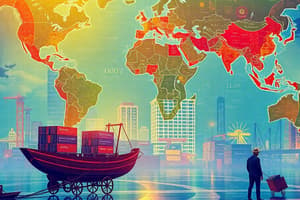Podcast
Questions and Answers
Which of the following factors is considered part of a company's internal environment?
Which of the following factors is considered part of a company's internal environment?
- Suppliers
- Competitors
- Financial resources (correct)
- Marketing intermediaries
Technological factors in the macro environment primarily affect manufacturing but have little impact on service industries.
Technological factors in the macro environment primarily affect manufacturing but have little impact on service industries.
False (B)
Name three demographic factors that can significantly impact a business's marketing strategy.
Name three demographic factors that can significantly impact a business's marketing strategy.
Population size, age distribution, income/wealth distribution
Changes in consumer values and lifestyles are part of the __________ environment that businesses must consider.
Changes in consumer values and lifestyles are part of the __________ environment that businesses must consider.
Match the following environmental factors with their corresponding characteristics:
Match the following environmental factors with their corresponding characteristics:
Which of the following macro environmental factors is most closely related with interest rates and business cycles?
Which of the following macro environmental factors is most closely related with interest rates and business cycles?
Which of the following activities falls under the category of primary industries?
Which of the following activities falls under the category of primary industries?
A company's purchasing policies are considered part of its macro environment.
A company's purchasing policies are considered part of its macro environment.
List three components of the micro environment
List three components of the micro environment
Secondary industries are primarily focused on providing support services to primary industries.
Secondary industries are primarily focused on providing support services to primary industries.
What is the primary rationale for a business to exist, according to the content?
What is the primary rationale for a business to exist, according to the content?
Business risks can lead to inadequate profits or even ______ due to uncertainties.
Business risks can lead to inadequate profits or even ______ due to uncertainties.
Which characteristic of business risk is correctly stated?
Which characteristic of business risk is correctly stated?
Identifying a developing market falls under which category of environmental scanning?
Identifying a developing market falls under which category of environmental scanning?
A firm's marketing expertise is considered a weakness when scanning the environment.
A firm's marketing expertise is considered a weakness when scanning the environment.
Match the following causes of business risks with their descriptions:
Match the following causes of business risks with their descriptions:
Which of the following best describes the primary motive behind engaging in business activities, according to the definition provided?
Which of the following best describes the primary motive behind engaging in business activities, according to the definition provided?
Commerce only involves the physical transportation of goods from one place to another.
Commerce only involves the physical transportation of goods from one place to another.
Briefly explain how trade facilitates the distribution of goods to the end consumer.
Briefly explain how trade facilitates the distribution of goods to the end consumer.
Activities that directly support and facilitate trade are known as _________ to trade.
Activities that directly support and facilitate trade are known as _________ to trade.
Why is profit considered an essential objective of business?
Why is profit considered an essential objective of business?
Which of the options is NOT considered a multiple objective of a business?
Which of the options is NOT considered a multiple objective of a business?
Match the following characteristics with their descriptions:
Match the following characteristics with their descriptions:
Which of the following best encapsulates the concept of 'business'?
Which of the following best encapsulates the concept of 'business'?
Flashcards
Business
Business
An occupation, trade, or profession; operations of trade or industry; a commercial enterprise or establishment.
Definition of Business
Definition of Business
An economic activity involving production and sale of goods/services to earn profit by satisfying human needs.
Commerce
Commerce
Activities removing hindrances of person, place, time, risk, finance, and information in the exchange of goods/services.
Trade
Trade
Signup and view all the flashcards
Auxiliaries to Trade
Auxiliaries to Trade
Signup and view all the flashcards
Profit Objective
Profit Objective
Signup and view all the flashcards
Multiple Objectives
Multiple Objectives
Signup and view all the flashcards
Characteristics
Characteristics
Signup and view all the flashcards
Primary Industries
Primary Industries
Signup and view all the flashcards
Secondary Industries
Secondary Industries
Signup and view all the flashcards
Tertiary Industries
Tertiary Industries
Signup and view all the flashcards
Rationale for Business
Rationale for Business
Signup and view all the flashcards
Business Risk
Business Risk
Signup and view all the flashcards
Causes of Business Risks
Causes of Business Risks
Signup and view all the flashcards
Business Environment
Business Environment
Signup and view all the flashcards
Environmental Scanning
Environmental Scanning
Signup and view all the flashcards
Causes of Business Failure
Causes of Business Failure
Signup and view all the flashcards
Micro Environment
Micro Environment
Signup and view all the flashcards
Macro Environment
Macro Environment
Signup and view all the flashcards
Micro Environment Components
Micro Environment Components
Signup and view all the flashcards
Demographic Factors
Demographic Factors
Signup and view all the flashcards
Political Factors
Political Factors
Signup and view all the flashcards
Economic Factors
Economic Factors
Signup and view all the flashcards
Technological Factors
Technological Factors
Signup and view all the flashcards
Study Notes
- Business means different things to different people.
Aspects of Business
- Business refers to occupation, trade, or profession
- Business includes operations of trade or industry
- Business includes a commercial enterprise or establishment
Definition of Business
- Business involves the production and sale of goods and services
- The objective of business is to earn profit by satisfying human needs in society
- Kibera (1996) defines business as an economic activity organized to manufacture or produce goods and services at a profit.
Important Business Terminologies
- Commerce consists of activities removing hindrances related to person, place, time, risk, finance and information in the exchange of goods and services
- Trade involves the sale, transfer, or exchange of goods and is essential to commerce, making produced goods available to consumers or users
- Auxiliaries to trade are activities that assist trade
Objective of Business
- Profit is seen as an essential objective for business
- Profit is a source of income for the business person
- Profit is a source of finance for meeting expansion requirements of business
- Profit indicates the efficient working of business
- Profit builds up the reputation of a business enterprises
Multiple Objectives of Business
-
Business objectives define what the business is going to do in concrete terms
-
Business objectives enable the business to analyze their own experiences to improve their performance
-
Specific multiple objectives
- Market standing
- Innovation
- Productivity
- Physical and financial resources
- Earning profit
- Manager performance and development
- Worker performance attitude
- Social responsibility
Characteristics of Business Activities
- Business is an economic activity
- Relates to the production or procurement of goods and services
- Involves the sale or exchange of goods and services to satisfy human needs
- Dealings in goods and services happen on a regular basis
- Includes profit earning
- A business has uncertainty of return
- There are elements of risks
Industry
- Primary industries are connected with:
- The extraction and production of natural resources
- The reproduction and development of living organisms
- Plant development
- Secondary industries:
- Use materials extracted at the primary stage
- Tertiary industries:
- Provide support services to primary and secondary industries
- Deal with activities relating to trade
Rationale for the Existence of Business
- Profit maximization forms the greatest rationale for the existence of business
- Businesses must gain revenue that exceeds costs to make a profit
- This is achievable through production and marketing of goods and services that satisfy human needs and wants
Business Risks
- Risk refers to the responsibility for inadequate profits or losses due to uncertainties or unexpected events
- Business risks arise due to uncertainties
- Risk is an essential part of business
- Degree of risk relies on the nature and size of the business
Causes of Business Risks
- Natural causes
- Human causes
- Economic causes
Business Environment
- A company's business environment consists of actors that affect its ability to develop and maintain good relationships with its customers
- Scanning is the process of identifying and interpreting environmental factors
Why Scan the Environment
- Identify opportunities
- A developing market
- Strategic partners
- New market
- To identify threats
- A new competitor
- Price wars with competitors
- Competitors new product or innovation
- New taxes
- New government regulations
- To identify a firms strengths
- Competitiveness
- Marketing expertise
- New innovations and process
- New products
- To identify a firms weaknesses
- Lack of information
- Poor product quality
- Undifferentiated products
- Lack of good planning
Components of Business Environment
- The business environment is divided into two main groups: micro environment and macro environment
Micro Environment
- Micro environment is divided into:
- Internal environment
- External environment
Internal Environment
- Marketing programs
- Financial resources
- Research & Development
- Manufacturing
- Purchasing policies
- Human resources
External Environment
- Suppliers
- Marketing intermediaries
- Customers
- Competitors
- Publics
- Institutions
- Distributors
Macro Environment
- Demographic factors
- Political factors
- Legal factors
- Economic factors
- Social-cultural factors
- Technological factors
- Natural environment
Demographic Factors
- Population Size
- Geographical distribution
- Mobility trends
- Age distribution
- Life expectancy
- Household/family size, makeup
- Income/wealth distribution
Political Factors
- Stability of the political environment
- Government policy influence on laws and regulations
- Government's position on marketing ethics
- Government's policy on the economy
- Views of the government on culture and religion
- Involvement of the government in trade agreements
Legal Factors
- Legislations
- Legal systems
- Fiscal and monetary policies
- Employment legislation
- Consumer protection law
- Foreign trade regulations
- Environment protection regulation
Economic Factors
- Interest rates
- Business Cycles
- Money supply
- Investment levels
- Balance of Payment
- The level of inflation
Technological Factors
- Whether technology cheapens products and services, improving their quality
- How technologies offer more innovative products in banking or mobile telephones for consumers and business
- How distribution is changed by new technologies e.g. books via the Internet, flight tickets options etc.
Social Cultural Factors
- Dominant religion?
- Attitudes to foreign products
- Roles of men and women within society?
- How long the population is living
- Opinion of the population about green or environmental issues
- Changes in consumer values and lifestyles
Studying That Suits You
Use AI to generate personalized quizzes and flashcards to suit your learning preferences.




